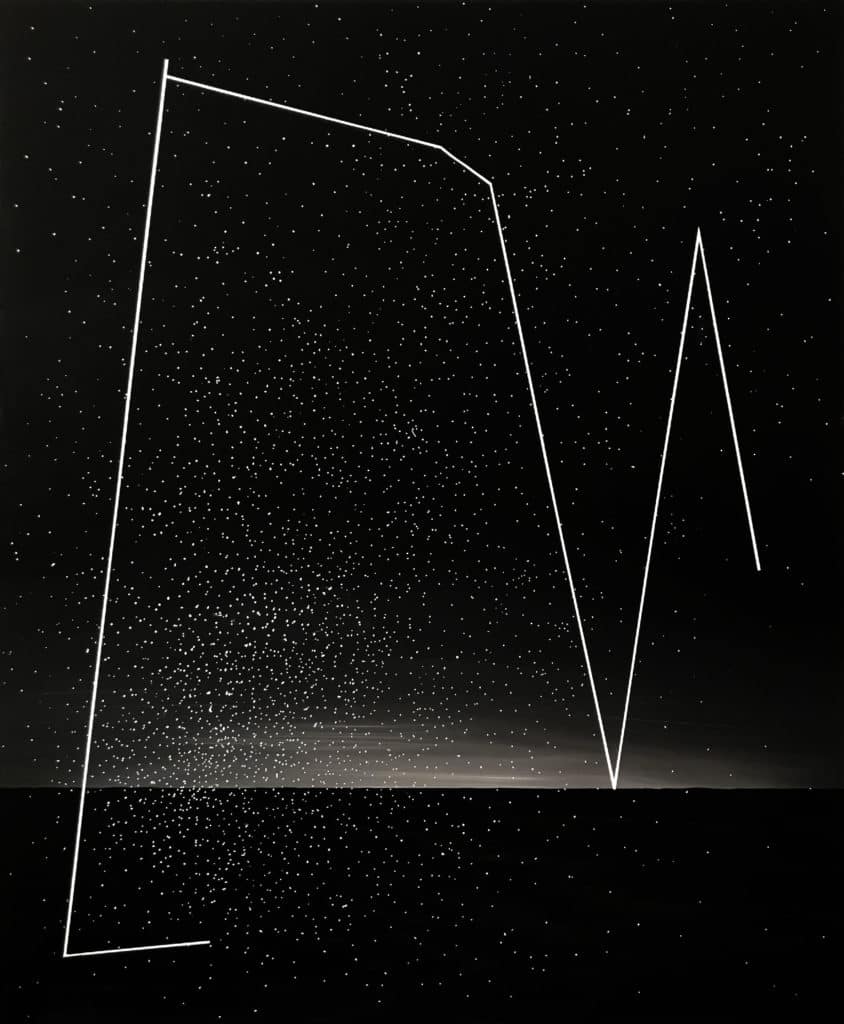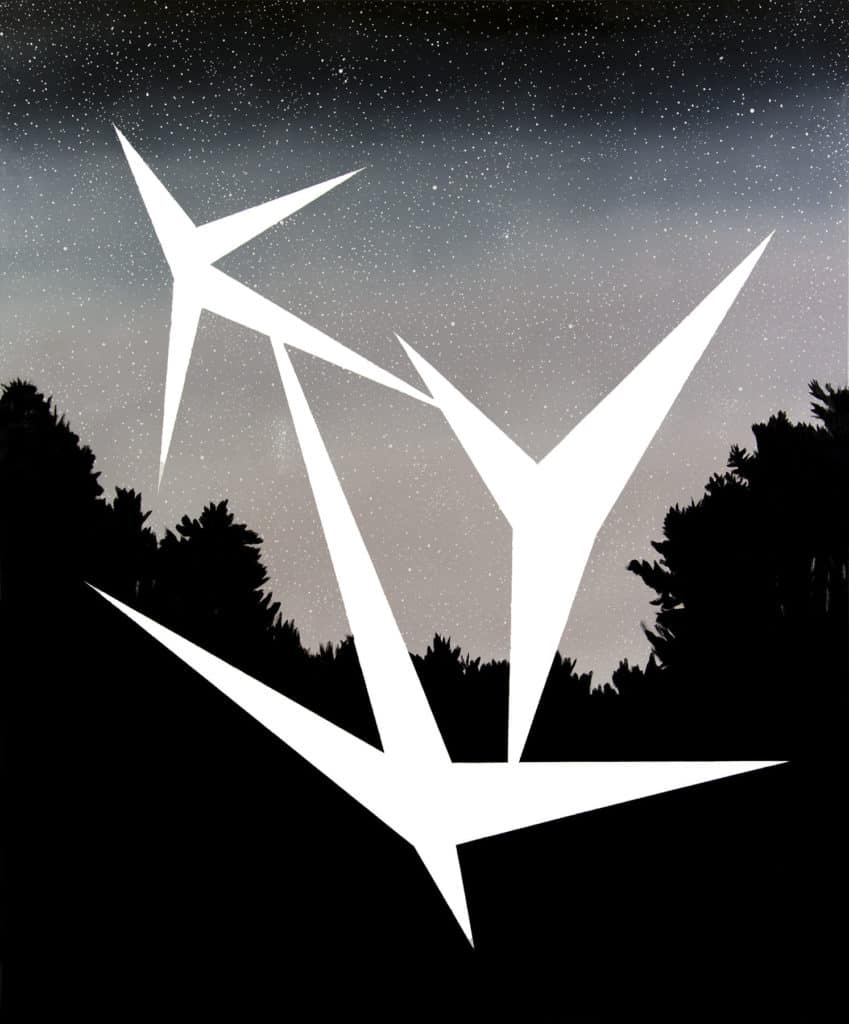On the occasion of a new solo exhibition of Łukasz Patelczyk at the Platan Gallery in Budapest, we talk with the artist about his technique, inspirations and plans. In ’’The Signs in the Sky’’ Polish painter presents his latest works: he offers a summary of all the issues he has been interested in, over the last few years. As in his most recognised art series, he smoothly connects the elements of the romantic landscape with the elements of abstract art.This time he invites us to read through celestial signs.
Patrycja Rup: In your artworks, realistic depictions of landscapes are distorted by abstractive elements: blurs of colour and light, geometric figures and lines, can be said that this strategy became a leitmotif of your paintings. Can you share with us how this creative process began and what was your primal inspiration?
Łukasz Patelczyk: I am mainly interested in the composition and framing. I often search for inspiring landscapes on the internet; I also take pictures of clouds, nocturnes. I love painting landscapes in which large areas of the canvas are covered by a flat black spot, such as mountains in the image ’’La Montana Sagrada’’. Sometimes, while I am just doing something trifling, a ready landscape comes to my mind. The next step is when it formes and creates more meaning, some kind of an abstract system. Often at the very beginning, it has no greater ideological significance, but over time it turns out that something is behind it, some alluring content, some condensed thought.
PR: In your paintings inspired by real photographs you cover certain elements with light fields, you hide/remove characters and situations, what kind of topics appeal to you at this level and does this activity reflect only your believes related to artistic problems or you want to convey other political and social statements?
ŁP: In fact, the actions that I take to create a synthesis of landscape and abstraction gives me the opportunity to smuggle social content or even current political comments in the work. However, I am very far away from describing myself as a person involved in politics. I think my art is about something else. Despite this, I sometimes create works such as the painting ’”Landscape after the Battle’’ (2014), in which black abstract forms associated with rugged flags symbolising the overthrow are implied in antic ruins.
PR: Which series of your works you find most significant in your artistic career, is there a specific work which you would name as crucial?
ŁP: One of the most important paintings I’ve created is undoubtedly the work that was made still while I was studying at the Academy of Fine Arts in Gdańsk. This untitled work from 2010 presents a landscape whose central part is covered by a white rectangle in the middle of the image field. A realistic landscape creates a kind of passe-partout for a white empty form. In the case of my currently painted series, I perceive them all as equivalent. These are not typical series of artworks that begin and end, and then there is no return to them. For me, it works differently, as I can return to some concepts after, for example, two years. I think that someday I will manage to staple all of these ideas together.
PR: What kind of media would you like to use in your future works? Which are most alluring and worth discovering for you?
ŁP: I have a few ideas that have been going through my head for a long time. I would like to create an extensive spatial installation made of metal rods and combine it with neon lights to work more with light and scale. Generally, I believe that every time I do something new, I learn and discover a lot during this process.
PR: Can you tell us more about the creation process behind works exhibited in Platan Gallery?
ŁP: This year at the Centre of Contemporary Art in Toruń and at the BWA Awangarda Gallery in Wrocław, I presented site-specific projects and at first in Platan Gallery, together with the curator Tomek Piars, we thought about applying a similar idea. Finally, considering the fact that this is my first solo exhibition in Hungary, we decided that it would be better to show a series of recent works, but ones which reflect the impact of my earlier series and significant topics that I dealt with in my career. July and August are also months of various astronomical phenomena, for example, we just experienced the Moon eclipse or falling stars, hence the title of the exhibition ’’Signs in the sky’’.
PR: Can you name artists or art pieces which significantly influenced your works?
ŁP: I try to travel a lot and discover as much as possible. I adore romantic painting and sacral painting of the Middle Ages. When I was still living in Gdańsk, I went many times to admire Memling’s famous ’’The Last Judgement’’. Among the artists I appreciate most are Hieronymus Bosch, Casper David Friedrich, considering contemporary artists I would mention Victor Man and Gerhard Richter.
PR: What fields you would like to explore in the future? Can you tell us more about your forthcoming projects?
ŁP: Currently, there are two exhibitions in Wrocław in which I participate. ’’Nietota’’ at the Wrocław Contemporary Museum and the ’’Brocken Spectre’’ at the BWA Awangarda Gallery. At the end of the year, ’’Nietota’’ will be presented in the Municipal Gallery BWA in Bydgoszcz. I’m also working on new projects that I will show next year.
Interviewed by Patrycja Rup – Polish curator and journalist. Lives and works in Budapest.
Edited by Contemporary Lynx
‘Łukasz Patelczyk. Signs in the Sky’ is curatored by Tomasz Piars.
On view until 31 August 2018 at the Platan Gallery, Andrássy Street 32 in Budapest
Biography:
Łukasz Patelczyk – born in 1986 in Wejherowo, Poland. Graduated in 2012 from Academy of Fine Art in Gdańsk. Participant of numerous solo and group exhibitions. Laureate of prestigious competitions in Poland: special prize and scholarship of Hestia Artistic Journey competition in 2011, press prize of the magazine Notes na 6 Tygodni during The 41st Painting Biennale ’Bielska Jesień’ 2015. Finalist of The Geppert’s competition (2011) and Perfectionist – I Internacional Painting Contest Modessqe (2013). In 2016 he was a laureate of the Cultural Scholarship of the City of Gdańsk. His works are in the collection of the National Museum in Gdańsk and in private collections in Poland and abroad.










